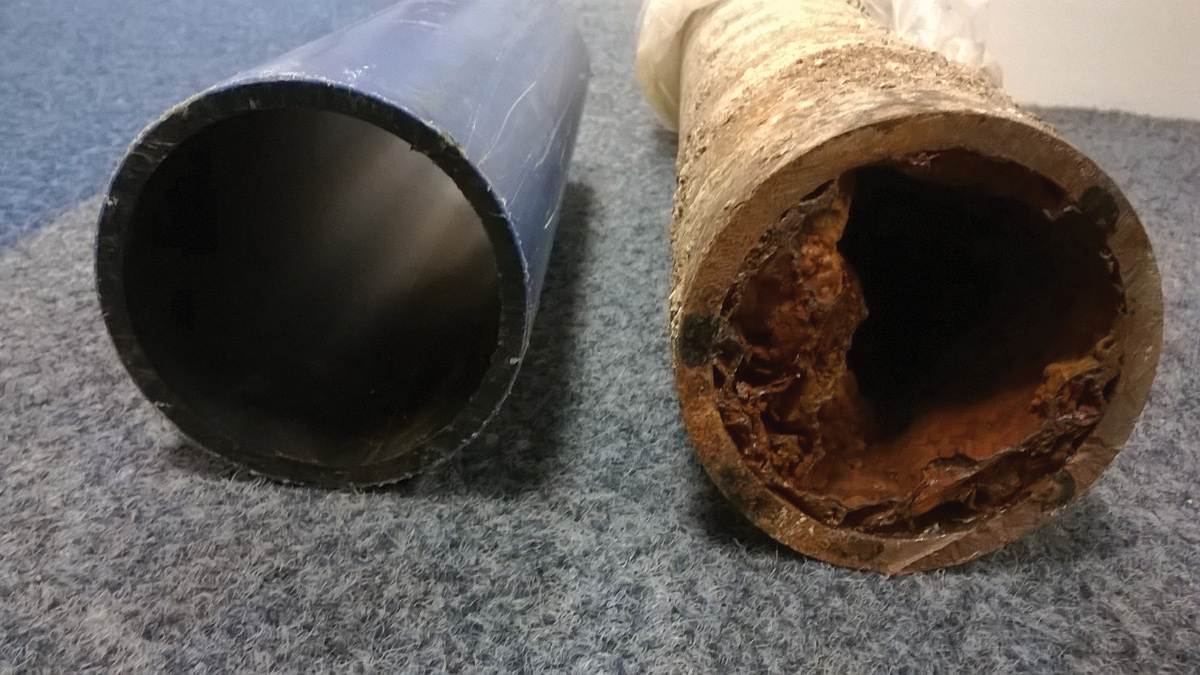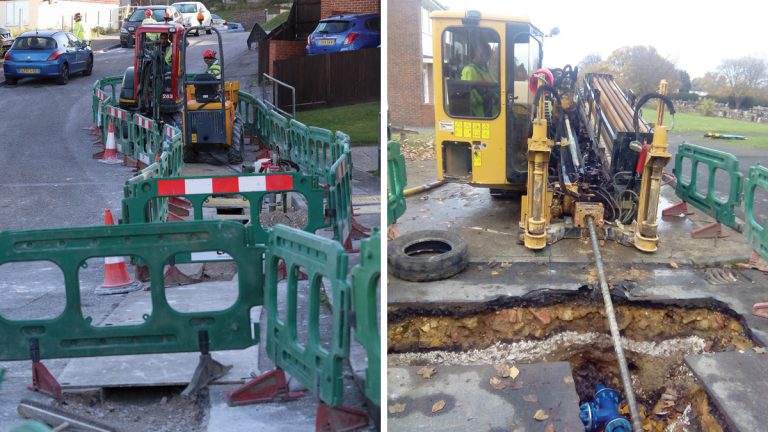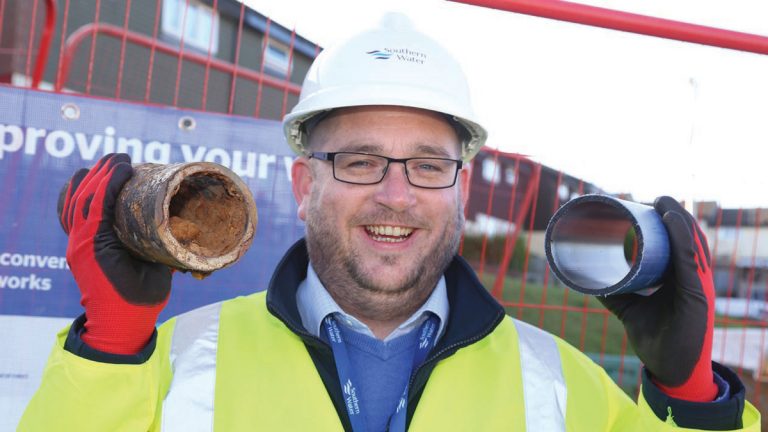Woolmans Wood Phase 2 (2017)

New polyethylene pipes replacing old cast and ductile iron pipes - Courtesy of Clancy Docwra
Between 2011 to 2013, Southern Water invested £14m replacing old water mains in the Chatham, Gillingham and Rochester. An additional £8 million is now being invested to replace a further 28km of 85-year-old water mains and service pipes to further improve water supply pipes and reduce the risk of discoloured water. The Chatham supply zone is predominantly urban, comprising a significant proportion of properties originally served by cast iron (CI), spun iron (SI) and ductile iron (DI) mains in diameters up to and including 9” dating as far back as 1870. This £8m scheme – one of the biggest water network projects undertaken in AMP6 – began construction in August 2016 and is due for completion by the end of 2017.
Background
The Woolmans Wood Phase 2 scheme is part of the Woolmans Wood Mains Renewal Project aimed at mitigating the risk of iron discolouration in the water supply to approximately 42,000 customers. Phase 1 of the project was completed in 2013 and required the replacement of 50 km of mains. A further 31km were scheduled for replacement during Phase 2.
Although water quality may meet the statutory requirements, consumers are likely to reject discoloured water on the grounds of appearance. Excess iron causes brown stains on laundry and plumbing fixtures and can also give a bitter taste to the water when present in amounts above 1mg/l.
Discoloured water in distribution networks is generally due to the presence of fine suspended iron oxide sediment in the fluid flow. Where the flow velocity is low, the sediment can settle out and accumulate over time. Where significant deposits of loose sediment accumulate, any subsequent hydraulic changes, such as those that occur during bursts or rapid changes in the direction or speed of the water flow, re-suspend the sediment and cause discolouration.
Previous studies concluded that discoloured water issues were mainly linked to corrosion products from unlined cast and ductile iron pipelines somewhere within the Woolmans Wood catchment which could be addressed by replacement with plastic alternatives such as polyethylene, thus improving the quality of the water delivered to customers and reducing the number of recorded customer complaints.
Project team
The project was delivered through collaboration of Southern Water’s in-house Engineering and Technical Solutions (ETS) teams along side its external construction partners. The ETS design team brought together experts in hydraulic, civil and mechanical engineering from Southern Water, MWH (now Stantec UK) and Mouchel to find the solution. Site investigations and pipe condition assessments were then undertaken by the Morrison Galliford-Try Joint Venture (MGJV), and Hydrosave, a condition assessment supplier. Clancy Docwra was appointed as the principal contractor for the scheme. This shared responsibility ensures that the project can deliver best value to the client and its customers.

(left) Construction underway – Courtesy of Southern Water and (right) Directional drilling installations – Courtesy of Clancy Docwra
Constraints
The scheme posed many challenges to the project team including scale, population density, high traffic volume, risk of service strikes, steep topography, and environmentally sensitive areas. Latest changes in the water industry regulations, such as the reduction in supply interruption periods from 6 to 3 hours for planned works, presented additional difficulties for the engineers and planners who had to adopt new practices and installation methods to reduce disruption to customers at no additional cost.
Design
Design approach: The limited availability of reliable GIS data posed one of the biggest project risks as definitive information about the pipes and their condition was either uncertain or unavailable. Knowing these parameters was crucial as the aim of designers was to establish a prioritisation model of water mains discolouration and based on this, develop a condition assessment inspection and renewal plan. The model required a range of pipe data including but not limited to material, age, presence of and type of coatings/linings, remaining life expectancy, failure history, tuberculation grading, flow velocities, and water quality.
Site Investigation: Design began with site visits, analysis of data records and consultation with local operational staff. This led to the identification of 2km of water mains being confirmed as polyethylene which subsequently did not warrant replacement. The preliminary appraisal also identified that approximately one third of the network comprised DI pipes. Contemporary DI pipes are supplied cement mortar lined as standard, but they have not always been in the past. Further investigation was needed to establish whether unlined DI pipes were contributing to the water quality issues. The remaining network pipelines comprising CI and SI pipes were the likely cause increased levels of iron and their exact location and tuberculation degree needed substantiation.
Engineers subsequently devised a comprehensive programme of visual and physical inspections undertaken on live pipelines to avoid any disruption to the day to day running of the network.
By selecting and combining the most modern assessment methods such as internal CCTV surveys, coupon extraction, and in situ non-destructive testing (NDT) using ultrasonic thickness measurements, the team ensured that all the necessary information needed to populate the model was acquired. Pipe sample cut-outs were not taken due to the need to maintain service.
The length of pipelines needing investigation required careful, opportunistic positioning and optimisation of the survey locations in order to minimise excavations, time and costs while being sufficiently representative of the network as a whole. This was achieved by procuring multistage trials and by locating pits at pipeline tee junctions to allow gathering of information of more than one pipe material/size within the same location. The entire site investigation operation comprised of approximately:
- 82 (No.) trial pits.
- 37 (No.) coupons extractions.
- 9 (No.) NDT assessments.
- 9 (No.) CCTV investigations.
This was remarkably compact considering the extent of the zone investigated: 5 (No.) district metering areas (DMAs) totalling over 40km of pipes. Results from field tests were then fed into the model which significantly increased the understanding of the network condition, enabling effective decisions on rehabilitation requirements to be made. The extent of the replacement was finally determined by adding high risk assets and removing the low risk assets from the model. A total of 9km of pipeline were removed from the initial scope of 40km making the project significantly more efficient, sustainable and cost effective.
Hydraulic modelling: Hydraulic modelling was used to analyse the performance of the existing distribution mains and to optimise the design of the replacement mains under the latest supply and operating conditions. The original Infoworks model was updated to reflect recent changes in the distribution system such as demand, operations, connectivity, and new mains materials.
Changes to minimum modelled pressures were then assessed and pipe diameters upsized where head loss gradient was considered unacceptable, i.e. greater than 10m/km, or downsized while still maintaining minimum pressure at the customer’s tap. Pipe sizes for strategic mains, i.e. mains that feed other areas during temporary emergency re-zoning, had been left unchanged owing to their hydraulic importance and to preserve network resilience.
The hydraulic studies showed that by selectively upsizing 6% of the pipes across the DMA’s, 28% of the new mains could be downsized from those that they replaced. The net result was a much improved water distribution system which provided a number of benefits including:
- Enhanced water flow velocities and turnover which in turns improve water quality.
- Ease of construction.
- Reduced capital cost and CO2 emissions.
Further design activities: In parallel, further work has been completed on the design and planning of the remedial works, including re-alignment of the location of mains to be replaced and rationalisation of service pipe arrangements. Environmental assessments were also undertaken to ensure natural habitats were preserved, any discovered challenges managed, and project timelines maintained.

The local school had a site visit, hosted by the project team. Community engagement is a huge part of this project – Courtesy of Southern Water
Construction
The pipe material specified was high density polyethylene (PE) PE100 SDR 17 with a maximum operating pressure of 10 bar. PE was chosen as it is unaffected by internal or external corrosion and allows for a fully welded system with no thrust blocks requirements. Using PE also meant that trenchless technologies could be adopted to provide additional benefits such as quicker installation with reduced traffic disruption, less ground works and, in particular, allows the use of pre-chlorinated coils to minimise service interruption time.
In-line methods of replacement such as PU spray lining, pipe bursting and slip lining were considered during the optioneering phase, but discounted due to the short installation window imposed by the current regulations.
Despite the high numbers of underground services and many other constraints typical of the urban environment, the predominant installation method used on the scheme was horizontal directional drilling with approximately 76% of replacement mains installed using this method.
The programme of works was split into seven geographical areas, each with dedicated construction crews working concurrently across the three towns. The project is currently on time and on budget, with 75% of the planned replacement pipelines already installed in less than a year. The remainder of the pipeline installation is estimated for completion by the year ending 2017. A one year programme of mains flushing will follow with a further year of network monitoring to confirm the success of the project.
A full-time liaison officer ensures that customers are kept up to date with work in their area and any possible disruptions. Since the start of the scheme more than 22,000 letters have been sent to customers; this proactive approach to communications in these heavily populated areas has seen us receive, on average, only 10 unwanted contacts a month.

Project manager Mark Newman with an old pipe and new – Courtesy of Southern Water
Conclusions
Through better targeting of high risks pipes via intelligent modelling and asset assessment, Southern Water was able to reduce the scheme scope and associated disruptions and interruptions, as well as reduce costs by several million pounds, for the delivery of a project which will significantly reduce the number and severity of discolouration events.
Additional scheme benefits include reducing the number of mains failures by prioritising existing high risk, poor condition mains for replacement, as well as improving network resilience. By designing a targeted solution that included a mixture of off line mains renewal and proactive flushing, SW was able to provide maximum value to our customers with minimum service interruptions.




